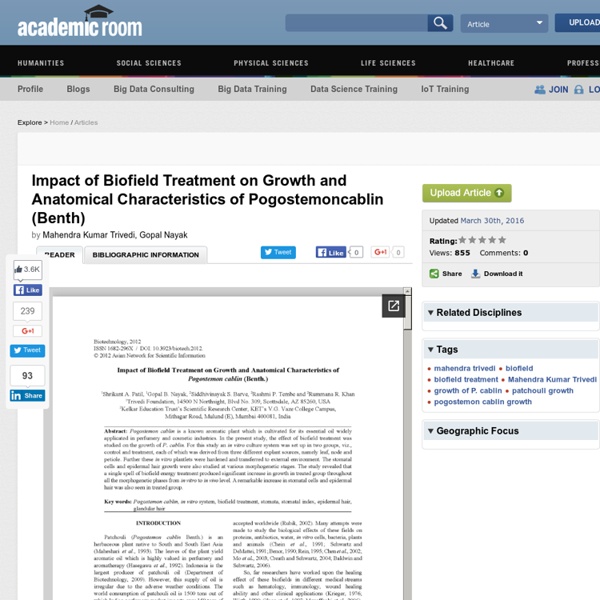



"Impact of Biofield Treatment on Growth and Anatomical Characteristics Description Pogostemoncablin is a known aromatic plant which is cultivated for its essential oil widely applicated in perfumery and cosmetic industries. In the present study, the effect of biofield treatment was studied on the growth of P. cablin. For this study an in-vitro culture system was set up in two groups, viz., control and treatment, each of which was derived from three different explant sources, namely leaf, node and petiole. Citation Information Mahendra Kumar Trivedi.
Biofield and Fungicide Seed Treatment Influences on Soybean Productivity,Seed Quality and Weed Community Biofield and Fungicide Seed Treatment Influences on Soybean Productivity,Seed Quality and Weed Community Soybean production in Iowa USA is among the most productive for rainfed regions in the world. Despite generally having excellent soils, growing season temperatures and rainfall, soybean yields are decreased by weed interference and inadequate available soil water at key stages of crop development. A field study was conducted at two locations in Iowa in 2012 to determine if seed-applied fungicide or biofield treatments influenced weed community, soil volumetric water concentration and soybean yield and quality. Application of biofield treatment resulted in lower density of tall waterhemp density, greater soybean stand density at R8 stage and greater seed pod-1 compared to the absence of seed fungicide and biofield.
"Impact of Biofield Treatment on Growth and Yield of Lettuce and Tomato" by Mahendra Kumar Trivedi Abstract Recent studies report the effect of biofield treatment on changes in structural characteristics of organic and inorganic matter, on cancer cells in vitro and on overall plant development. This study tested the impact of the same treatment applied to lettuce and tomato seeds and transplants (Lactuca sativa var. capitata and Lycopersiconesculentum var. Impact of Biofield Treatment on Growth and Yieldof Lettuce and Tomato Australian Journal of Basic and Applied Sciences, 6(10): 100-105, 2012 Corresponding Author: Shrikant Patil, Trivedi Foundation, Scottsdale, AZ, USA. E-mail: shrikant@trivedifoundation.org, Tel: 1-877-493-4092 Fax:1-480-320-3727 Impact of Biofield Treatment on Growth and Yieldof Lettuce and Tomato 1Vishal Shinde, 1Frank Sances, 2Shrikant Patil and 1Amy Spence 1Pacific Ag Research, San Luis Obispo, CA, USA. 2Trivedi Foundation, Scottsdale, AZ, USA. Abstract: Recent studies report the effect of biofield treatment on changes in structural characteristics of organic and inorganic matter, on cancer cells in vitro and on overall plant development. tested the impact of the same treatment applied to lettuce and tomato seeds and transplants (Lactuca sativa var. capitata and Lycopersiconesculentum var. fertilizers and pesticides, in relation to yield, quality, and pest inhibition. fertilizer and pesticide applications were more vigorous, exhibited less incidence of soil-borne fungal nature. conditions.
"An Effect of Biofield Treatment on Multidrug-resistant Burkholderia ce" by Mahendra Kumar Trivedi Abstract Burkholderia cepacia (B. cepacia) is an opportunistic, Gram negative pathogen which causes infection mainly in immunocompromised population and associated with high rate of morbidity and mortality in cystic fibrosis patients. Aim of the present study was to analyze the impact of biofield treatment on multidrug resistant B. cepacia. Clinical sample of B. cepacia was divided into two groups i.e. control and biofield treated. The analysis was done after 10 days of treatment and compared with control group. Citation Information Mahendra Kumar Trivedi.
Antimicrobial Sensitivity Pattern of Pseudomonas fluorescens after Biofield Treatment | Open Access | OMICS Publishing Group Due to the high frequency of antimicrobial resistance among clinical isolates of P. fluorescens, it causes serious problems in the choice of an appropriate antimicrobials in the past 15 years. P. fluorescens was isolated in bottled water and causing bacteremia and pseudo bacteremia in immunocompromised patients in hospitals from contamination of disinfectants and blood collecting tubes [22]. Although P. fluorescens considered to be non-pathogenic to humans, but recent reports on clinical strains of P. fluorescens have cause serious health problems [23-25] which require some alternative treatment approach. Ceftazidime is the choice of drug used against P. fluorescens infection, either alone or in combination with gentamicin. P. fluorescens was highly sensitive to kanamycin, tetracycline, and chloramphenicol at very low concentration [26]. In biomedical health care system, biofield therapies are very popular and claims to enhance human well-being and other metabolic pathways [28-30].
Spectroscopic Characterization of Disulfiram and Nicotinic Acid after Biofield Treatment Trivedi, M. K. (2015), 'Spectroscopic Characterization of Disulfiram and Nicotinic Acid after Biofield Treatment'. %0 Thesis %1 mahendrakumartrivedi %A Trivedi, Mahendra Kumar %B Spectroscopic Characterization of Disulfiram and Nicotinic Acid after Biofield Treatment %D 2015 %I Mahendra Kumar Trivedi %J Analytical & Bioanalytical Techniques %K biofield mahendrakumartrivedi myown %N 5 %T Spectroscopic Characterization of Disulfiram and Nicotinic Acid after Biofield Treatment %U %V 6 %X Disulfiram is being used clinically as an aid in chronic alcoholism, while nicotinic acid is one of a B-complex vitamin that has cholesterol lowering activity. The aim of present study was to investigate the impact of biofield treatment on spectral properties of disulfiram and nicotinic acid.
Spectroscopic Characterization of Disulfiram and Nicotinic Acid after Biofield Treatment *The embed functionality can only be used for non commercial purposes. In order to maintain its sustainability, all mass use of content by commercial or not for profit companies must be done in agreement with figshare. Description Disulfiram is being used clinically as an aid in chronic alcoholism, while nicotinic acid is one of a B-complex vitamin that has cholesterol lowering activity. Published on 13 Oct 2015 - 12:07 (GMT) Filesize is 1.35 MB License (what's this?) Cite "Filename" Place your mouse over the citation text to select it Embed "Spectroscopic Characterization of Disulfiram and Nicotinic Acid after Biofield Treatment" Show filename on top Place your mouse over the embed code to select and copy it